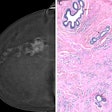CHICAGO - Using ultrasound as an adjunct to mammography for breast cancer detection can significantly improve diagnosis, according to researchers from Maastricht University Hospital in Maastricht, the Netherlands. Dr. Karin Flobbe presented the results of her group’s study on Friday at the RSNA show.
"Although the literature clearly supports the use of ultrasound in breast imaging, we found no guidelines for who would benefit the most from use of this modality. So, we set out to define the subgroups that would best benefit from breast ultrasonography performed in addition to mammography," Flobbe said.
This prospective study was conducted between October 1999 and August 2000. All consecutive patients referred for mammography underwent additional ultrasonographic examination. The same operator performed a clinical exam and mammogram. In total, 3,835 breasts were examined in 2,020 patients.
The results for the clinical exam, mammogram, and ultrasound were scored according to the five-point BIRADS lexicon and were then linked to pathology results after a minimum follow-up period of six months, and a maximum of 12 months. The researchers used the pathology results as the study’s gold standard.
The team calculated the diagnostic value of the ultrasound-exam component by constructing receiver operator characteristics (ROC) curves of the data and comparing the areas under the curves for ultrasound/mammography/clinical evaluation vs. mammography and clinical evaluation. The patient subgroups were defined according to the reason for referral.
Flobbe reported that 131 malignancies were detected in 128 patients, resulting in a prevalence of 6.3%. She noted that both the sensitivity and specificity of the ultrasound/mammography/clinical evaluation was 95%. The addition of ultrasound significantly improved the diagnostic value of this population: 0.977 for both modalities and clinical exam vs. 0.950 for mammography and clinical evaluation.
Patients referred for palpable breast lumps and who were older than 50 years, as well as patients referred from the U.S. National Breast Screening Program, benefited the most from the ultrasound. However, breast ultrasound had no additional diagnostic value in patients referred for follow-up of a former breast malignancy or benign pathology. Additionally, no additional diagnostic value was found for ultrasound in patients referred for screening and in examination of the contralateral breast.
On the basis of its study, the team concluded that the following subgroups would benefit most from ultrasound examination in addition to clinical evaluation and mammography:
- Patients with palpable lumps.
- Referrals from the National Breast Screening Program.
- Patients with symptoms other than palpable lumps.
- Patients with malignancy.
- Patients with benign lesions.
- Patients with a family history of breast cancer.
"We feel that use of breast ultrasound, in addition to a clinical evaluation and a screening mammogram, for these subgroups has tremendous efficacy in improving the diagnosis of breast cancer in this population," Flobbe said.
By Jonathan S. BatchelorAuntMinnie.com staff writer
December 3, 2001
Related Reading
New ultrasonic approach focuses on breast imaging, November 27, 2001
Ultrasound marks metastatic lymph nodes for breast cancer staging, October 17, 2001
Compound ultrasound scores big in breast imaging, May 9, 2001
US compound imaging offers more breast lesion detail than traditional sonography, May 1, 2001
Copyright © 2001 AuntMinnie.com



















